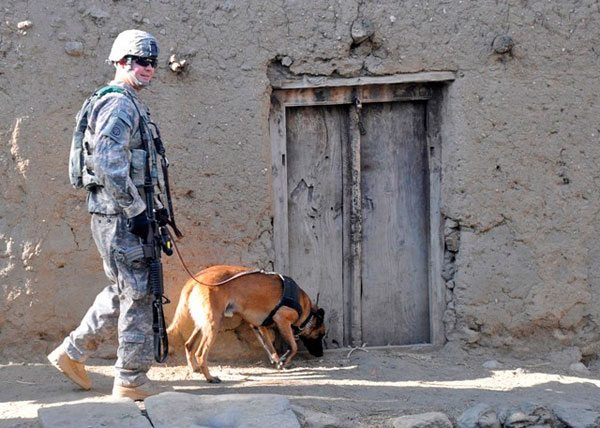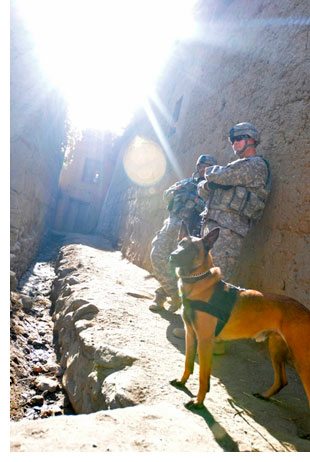
On a somber note, one of the Army Dog Handlers who was interviewed in this article, Spc. Brandon Steffey (not pictured) , was recently caught in a roadside bomb (IED.) Both Spc. Brandon Steffey and his dog were killed. Our hearts and thoughts go out to his family and friends.
— Kenn
Story and Photos by Spc. Derek L. Kuhn 40th Public Affairs Detachment
LAGHMAN PROVINCE, Afghanistan — Some of the best tools at the Army’s disposal aren’t always the latest and greatest pieces of high tech gadgetry. Sometimes there is a low tech solution for high tech problems. To date, the Army hasn’t any piece of technology as effective at discovering ordinance, improvised explosive device components or IED builders, than the noses of military working dogs.
Military working dogs work paw in hand with their handlers to help make Afghanistan a safer place for Afghans and Coalition Forces.
In Laghman province, Military working dogs help find militants that build, place and detonate IEDs.
U.S. Army Staff Sgt. William Burger, the non-commissioned officer in charge of Forward Operating Base Fenty Kennels, said the dogs are very quick and efficient when performing their duties, which includes searching houses.
“Having a dog go in (a house) is a lot safer (than sending in Soldiers),†Burger, a native of Mountain Top, Pa., said, “because the dogs don’t stumble onto anything. If they smell something, they will sit and then we’ll get (explosive ordinance disposal) to come check it out.â€
This is good because if a Soldier was searching and didn’t know an explosive was there he could accidentally set it off, Burger said.

Spc. Brandon Steffey, a combat tracking dog handler for Fenty canine, agrees with Burger and notes other advantages of using military working dogs.
“They move quickly,†the Sault St. Marie, Mich., native said. “The dogs are able to search an area more thoroughly with much more speed and safety than (humans).â€
This allows Soldiers to move more quickly onto their next risky objective.
Though finding IEDs and those who build them can be dangerous, to the military working dogs, their job is fun.
“It’s a game,†Burger said. “To them (the dogs), finding bombs is fun. It is like hide and seek.â€
Though the handlers know that being in Afghanistan is not a game, they appreciate having the opportunity to contribute with their special skill set.
“During my last deployment in Iraq, I couldn’t do my job,†Steffey said. “I was a gunner, but here I’m doing my job. I like being able to get the bad guys with my dog.â€
Regardless what mission they are doing, the dog handlers appreciate the risks they and their dogs are taking each day in Afghanistan.
“They are like Soldiers,†Steffey said. “They risk their lives just like us. Their lives are in our hands and that is why we look out for them.â€
Such risk requires the dogs and handlers to spend a lot of time training together, so they are mitigated, Burger said.
“Dealing with a dog, teaching a dog and watching him execute his job is very rewarding,†Steffey said. “I spend a lot of time with my dog and he is my best friend. We are a team.â€
Burger shares Steffey’s sentiments and takes pride in his job.
“Dogs save lives,†Burger said. “They are a great asset here and I’m proud to be a part of it.â€


Worlds most intelligent dogs. Salute!